Synergistic Research HFT
Imagine a handful of tiny aluminum cylinders attached to the walls of your listening room, let’s call them HFTs. In the last couple of weeks you’ve really worked hard to put them at right spots and now you feel that they contribute to how your system sounds. Other family members and visitors to your room exchange tolerant glances and quite understandably so – the tweaks like the HFTs fall, according to any reasonable standards, to the same category as fairies and alien abductions. The seed of doubts about your own sanity starts to grow and one night, when everyone is asleep, you start to remove them. The first is gone and the orchestra shrinks between the speakers. Second is gone and the opera diva drops down to an invisible chair and develops some obvious articulation problems. Another two are gone, and it is clear that someone has closed the piano board and put a thick wooly blanket over it. In panic you re-attached the cylinders back to the walls and sigh with relief – everything is back. Welcome to Synergistic Research.
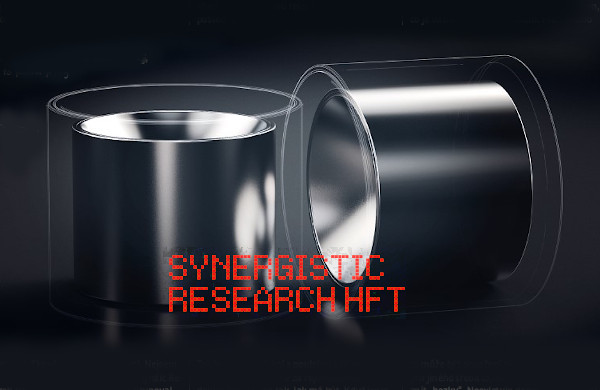
How many butterflies can change the acoustics of your room?
The HFTs are an invention of Ted Denney, the ideation engine behind everything what Synergistic Research makes. He considers a listening room to be an ecosystem – the room, the electronics, the power supply, the listener and the interferences, all these matter, including a cat that sleeps in a corner. Each ecosystem should be in balance and synchronization; once the system is out of the balance its parts will suffer. I assume each of us experienced an upgrade in amplifier which, as a consequence, forced us change the cables no matter how carefully they were selected to match the original amplifier. A new balance had to be established. The Synergistic Research products represent a cobweb of products that – if applied correctly – can synchronize individual parts of your system into a new supercharged whole.
HFT ecosystem
The High Frequency Transducers (HFT) are little silvery cylinders from metal that feels and looks like aluminum. They are 8mm tall and 10mm in diameter, with a horn-like waveguide that narrows into what looks like a miniature grille mesh. The HFTs are certainly not new to market but since recently the offer has been extended into other specialized types:
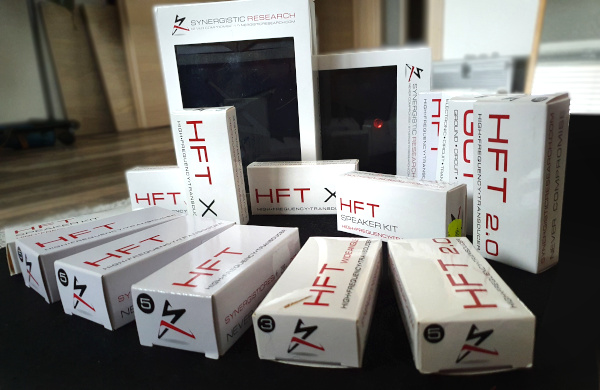
The original HFT's are the foundation of the HFT treatment. Although I found that any other HFT type contributes to better sound, and often significantly so, the original HFT did 80% of the job. Appearance: Natural aluminum.
Packed by: 5’s and 10’s
Placement guide: https://synres.wpengine.com/wp-content/uploads/2017/02/HFT-Instructions.pdf
HFT-X transducers are used instead of (or on top of) the existing HFT installation to add focus and resolution.
Appearance: They look identical to the HFTs, with slightly different silvery-gold waveguides.
Packed by: 3’s
Placement guide: https://synres.wpengine.com/wp-content/uploads/2017/02/HFT-2.0-X-Instructions-2.pdf
HFT 2.0 transducers can be used to manipulate warmth and richness of timbres. Synergistic Research recommends to combine a reasonable number of the HFT-Xs and the HFT 2.0s to achieve your preferred balance.
Appearance: They look identical to the HFTs, have black painted cylinders.
Packed by: 5’s
Placement guide: https://synres.wpengine.com/wp-content/uploads/2017/02/HFT-2.0-X-Instructions-2.pdf
HFT Wide Angle transducers are claimed to have a wider and more powerful dispersion pattern to increase the sense of immersion in the soundstage. They should not be ideally used on their own but always added with modesty to the existing installation.
Appearance: A bigger and much shallower version of the HFT, natural aluminum.
Packed by: 3’s
Placement guide: https://www.synergisticresearch.com/wp-content/uploads/2018/04/HFTwideManual.pdf
HFT GCT transducers are not placed around the room, rather they should be attached to or near the grounding points (chassis grounds, IEC grounds, ground posts, and if applicable inside the chassis on ground traces of PCBs or fuses). They are claimed to increase warmth and harmonic richness, and to lower electronics’ noise floor.
Appearance: They look identical to the HFTs, have black painted cylinders and purple waveguides.
Packed by: 3’s
Placement guide:
https://www.synergisticresearch.com/wp-content/uploads/2018/08/GCT_Instructions_Placement-1.pdf
HFT ECT transducers are meant to “clean up high frequency noise” when attached to transformers, tubes, cable connectors, chassis and even integrated circuits. Your system should benefit by “higher resolution and an increase in soundstage scale with improved mid-range clarity and low frequency control”.
Appearance: They look identical to the HFTs, have black painted cylinders and red waveguides.
Packed by: 5’s
Placement guide: https://www.synergisticresearch.com/isolation/accessories/ect/
HFT Speaker Kit are ready to use sets of the HFTs (4), the HFT 2.0s (2) and the HFT-Xs (2) in one box to get the best out of your speakers and make them disappear in your room. They are attached to strategic positions of the speaker cabinets. For 2 speakers 2 sets will be needed.
Placement guide:
https://www.synergisticresearch.com/wp-content/uploads/2017/11/HFTSpeakerPlacementAll.pdf
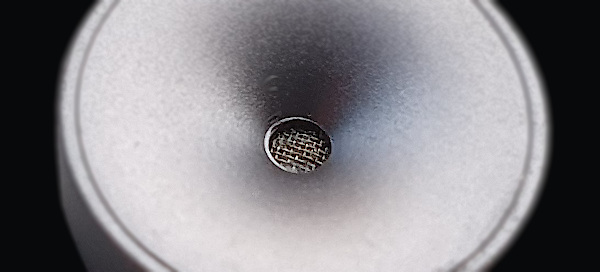
All the HFTs are passive things, they don’t need batteries or power supplies. They are simply attached to walls, speakers and electronics by blue tack that can be get at a stationery store - Pritt and Kores makes several types, I recommend the grey one or red one as they have better thermal stability and do not run. A small dab of the tack between the cylinder and the wall does the job and if needed the HFT can be easily de-attached and re-attached until you find the right spot. In extreme cases you may end up with some HFTs on curtains, picture frames and books – if there is no better place and the particular HFT yields the best result there just live with it. The only condition is that the HFT ‘sees’ the opposite wall or the listener or the speakers, that’s what I have found.
The benefits of the HFTs are cumulative. With only 1 pack of the HFTs the improvement will be audible, with 3-4 packs in different combinations it can be mind-blowing. The placement guides of Synergistic Research are excellent to start with. After you learn what each HFT does for the sound you’ll probably fine tune their positions and certainly regroup some of them. Still, the placement guides are well thought and save you from fruitless blind experiments.
So, how many butterflies do you need?
What reads like a Zen question is not far away from how these small Synergistic Research things work. There are myriad ways in which we misperceive reality, say the old teachings, and this happens mostly through our own ignorance.
When I opened a big box full of HFT packs I knew - 100% certainty – that the HFTs would not change anything. Another pro-forma review, another burnt weekend. So I started in a really agnostic way.
Interlude 1: An upright piano
I asked my 10 years old son to play few chord progressions on our upright piano, over and over again. The piano is by the wall in quite a large semi-open space that is on a rather live side in terms of acoustics, and I attached four HFTs on the piano: one on each side, one in the midway between pedals and the keyboard, and one on its top board, firing into ceiling. The sound of piano perceivably did not change – or so I thought – with the HFTs in place. Then I removed them and listened again. It was slightly different. So I repeated the test few times. As usual, the ear is more sensitive to subtracting than adding and the difference became noticeable, although subtle. It was as if the sound lingered longer and was more detached from the piano itself, not unlike the room would become livelier than it actually was. When the HFTs were removed the sound contracted and got drier, less effervescent. What is the take-away? The effect of the HFT could not be ignored and was repeatedly detectable on a real music instrument. Was it for better? Yes and no. This encouraged me to get the HFTs employed in my listening room.
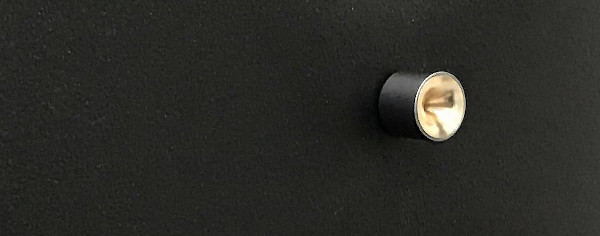
The first HFT pack, Level 1
After installing the HFTs according the instructions and fine tuning their positions I got fascinated by how easily I could move the center vocal in all three axes - left to right, up and down, and closer and farther away from the phantom center of the soundstage. It became clear that I had a unique opportunity to get the soundstage imaging right. For that I needed to use recordings where the spatial information is both encoded and known. So for many hours to come I settled with Alison Krauss’ Jacob’s Dream and Down to the River to Pray, Vilde Frang’s Schubert recordings, David Chesky’s and Stereophile’s test discs, or period recordings of jazz duets. All those either publish photos or videos from recording sessions, or do have detailed liner notes about where musicians were in relation to microphones. Sure, this not 100% bullet proof method either but if an acoustic guitar comes from the same height like vocal and you know that the guitar player was seated while the singer was standing, it is pretty indicative about incorrect imaging in your room, isn’t it?
So with only 5 small HFTs I spent hours by moving them on the front wall before I got it right. When I was done I could hear heads moving behind the mikes, a saxophone bell vertical movements during a solo, horns coming over and from behind the strings, a foot tapping the floor on the floor, and other delicacies that were spatially obscured before. I mind you: all this with 5 HFTs on the front wall only.
It was time to test my own integrity. I removed the two upper HFTs from their positions. The ceiling dropped by 50cm and compressed the music vertically. The guitars became hollower, more boxy. A double bass got softer and less ‘plucky’. The HFTs went back on the wall.

The second HFT pack, Level 2
By placing the HFTs on side walls I could improve the front-to-back perspective of the soundstage. Like in the previous step, the vertical balance and the accuracy of timbres were easily ruined when the side-HFT was placed too high or too low, too close or too far. Depending on your listening preferences it is very important to know what your goal is. It may be reconstructing the real live set acoustics, as well as it may be that the music sounds ‘nice’ to your ears. There is no wrong or right, but you need to use relevant recordings then. Of course, the mission is much easier accomplished if genres like electronica or rock prevail in your library. Getting a string quarter really right is a chore.
After successfully attaching the second set of HFTs to the wall and fine tuning their positions the sound was not far from holographic. The soundstage opened, got incredibly layered, the sounds snapped into focus, the air was pumped into the room. Still, I could choose, just by moving the HFTs a bit, whether the vocal should be breathier and airier or rather tube-like dense and saturated.
Interlude 2: Real people
I assume that the HFT must change the acoustic properties of the room. What else could they affect if not the resonant structure of room modes? So if they can make loudspeakers sound different then they must make everything sound different in the room. The hypothesis was easy to test. I invited family members in the room and let them talk, with and without the HFTs in place. The difference was similar to what I heard with music – with the HFTs the room had perceivably more air, however without any accentuation of sibilants or reintroduction of slap echo that I would expect from “live” room. Quite opposite, the people and the room sounded sweeter and more articulate in midrange and treble, as if the HFT levelled some spikiness which I was not aware of before and improved legibility of the human voice.
The more HFTs are on the walls and ceiling (Level 3 and Level 4), the more precision in their placement is needed. With the introduction of the new HFT-types, the HFT Wide Angle, HFT-X and HFT 2.0 I don’t think it is reasonable to go beyond Level 3 – once you start to add the specialized HFTs you’ll be forced reassess the positions of the already attached HFTs from Level 1 and Level 2 anyway. Let’s look what the specialized HFTs can offer to what I assumed unimprovable.
Adding the HFT-Xs to the positions that intuitively meant focus (centered between speakers and centered on speakers) improved focus and it did so in a rather dramatic way. When I replaced just one central HFT on the front wall with one HFT-X it was as if I attracted more energy there. The music got tighter, more colorful and, well, more musical. The instruments acquired more weight and slam. The voice’s breathiness was shifted towards solid contours – a bit less ethereal, more of a real person. Of course I missed the extra aura initially but after going back and forth several times it worked better to have the real 3D person in front of me than a hovering projection of the person’s voice, no matter how much of air surrounded it.
The HFT 2.0s improved the wholeness of the presentation even further. They did not provide the same hyperfocus like the HFT-Xs but they became indispensable in building perspectives within the soundstage. By replacing certain HFTs strategically with the HFT 2.0s I could easily delineate every single performer in the choir of Down to the River to Pray a capella piece, or on New York Polyphony’s Lamentationes SACD disc. By delineation I mean that every single individual now could be seen/heard within the soundstage, in flesh, dynamic in his/her movements. It was with the HFT 2.0s that I literally spent two full days moving them on the walls by 0.5cm increments to all directions before they ‘clicked’. But the moment they did, the listening became augmented reality and the soundstage accuracy became almost surreal.
Similarly, with the HFT Wide Angle’s I could choose how ambient the soundstage should be. Although I loved the elevated sense of ambience that extended behind my listening seat and pushed the walls farther away, at the end I decided I could do without the Wide Angle’s. With them in place the frontal phantom images became more diffuse and this was the trade-off I did not accept. However, it will be very room-dependent and what worked for me may not work for you.
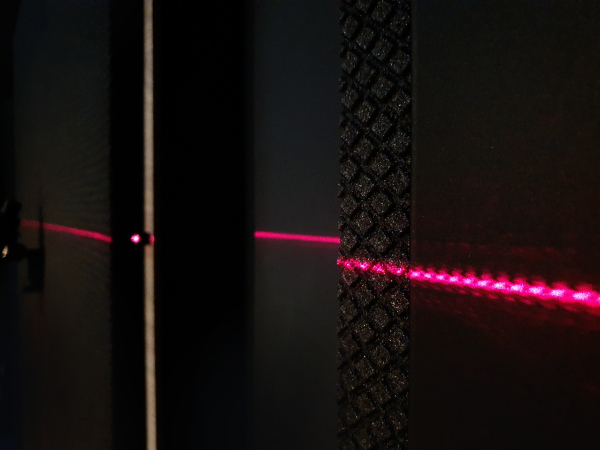
Interlude 3: Accuracy
Think of working with the HFTs like mapping the room. Step by step you learn how to manipulate your room’s sound. With every accurately attached HFT the sound becomes clearer, firmer, more articulated, and more natural and smoother at the same time. Accuracy is the key word in the process. Some sweet spots for the HFTs are found very fast. Testing is simple – just remove them or move them a bit and listen again. I already mentioned that the more the HFTs were in the room the smarter I had to be in finding the right spots for new ones. Give it time, a lot of time actually, and the results may be otherworldly. The ideal spot is often just centimeter or two from the current position, sometimes just few millimeters make a difference. Be systematic and slow. Be ready to re-evaluate and challenge any previously achieved balance – even better balance may lurk around the corner. I recommend using a cross-line laser for faster and more accurate wall mapping. I also recommend masking tape as it is easier to attach the HFTs to it than to the walls, until you are 100% satisfied. Be prepared that you may need meters of the masking tape and that a tape measure will become your best friend for days. How will you know that everything is right? Moving or removing a single HFT makes the sound implode. So, persist, it’s worth it.
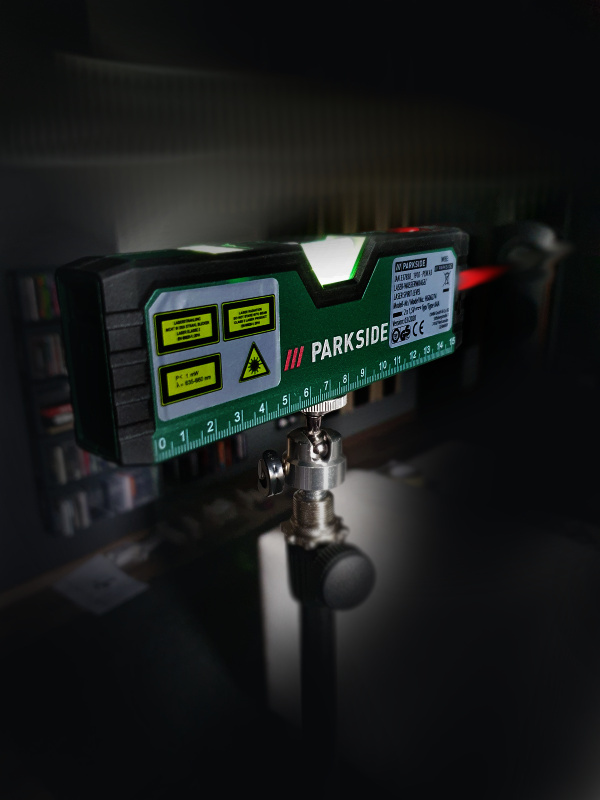
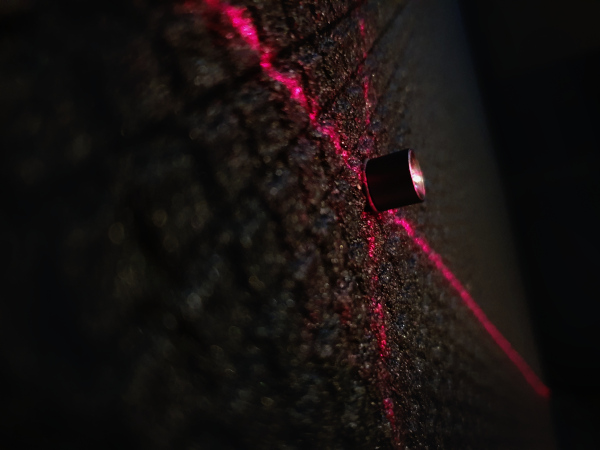
The speaker sets
The sets for loudspeakers are much easier to work with – you won’t need any measuring tools and the correct positions are found pretty fast. The trick is to find the right combination of HFTs which still opens quite a number of possible scenarios.
I am not going to spend too much time on these as each speaker is different in how cabinets are wide, deep and curved, how many drivers in what arrangement they employ, where ports are located, and so on. In my situation it was also complicated by the fact that TAD Evolution Ones do have concentric midrange and treble drivers, so the suggestions like “between the tweeter and midrange” did not apply. Anyway, here are several examples.
When I attached one HFT-X below the concentric drivers I got an effect similar to changing generic vacuum tubes to NOS Mullards: the sound got extremely physical and tangible, sweet, shimmering and weighty, with the vocalist making a step forward from the speaker’ s plane. The music acquired an indescribable 4th dimension that – with my eyes closed – was like a presence in a recording studio. Not behind the glass partition from a sound engineer’s perspective, but in the studio with the artists. I employed the track #44 from Chesky’s Jazz sampler, a deceptively simple recording of an acoustic double-bass on one mike. With the HFT-Xs I could ‘adjust’ its sound. I could choose whether I prefer to hear more of its strings or more of the instruments’ large body, I could choose how strong should be the attack and how long the decay, and I could choose how tall the double-bass should be. Once again, by incremental adjustments of the position of one single HFT-X on each baffle I finally got it right. Was it an illusion?
I removed both HFT-Xs and replaced them with original HFTs at the very same positions. The double bass got flatter and taller and sounded like a neck with strings to which a subwoofer is attached. The wholeness of the presentation and the ambiance like distant reflections from a large studio’s walls were largely suppressed. I removed the HFTs entirely and the balance did not change a lot, however I was now relegated into the position of the engineer behind the glass, a watcher not a participant anymore.
The GCTs a ECTs
I admit that that I could not properly test the ECTs. They should be used on transformers, tubes and PCBs. I was not going to disassemble neither the milled aluminum block in which my TAD amplifier is encased, nor the multilayered chassis of my Accuphase SACD player. I tried the ECTs in proximity of signal outputs and speaker binding posts, and I tried them on speaker’s cross-over assembly which can be easily reached from below the speaker’s aluminum plinths. Not surprisingly the last placement had the greatest effect for here the ECTs were close to cross-over components. The chassis of the amp and the player are built like tanks and are designed to block the EMI so apparently there is very little that the ECTs can pick up and attenuate.
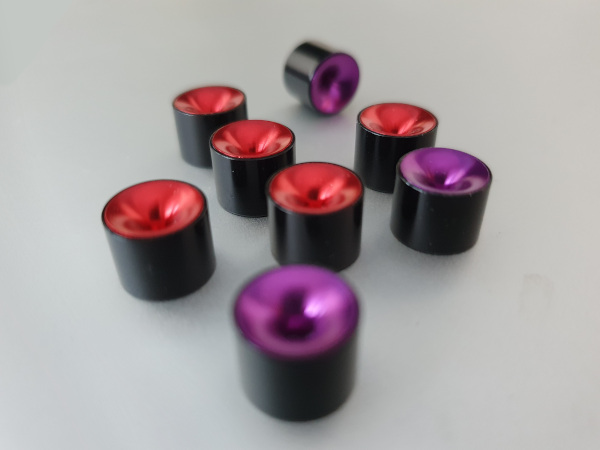
For the GCTs the options were multiple. The grounding scheme of my set-up is pretty complex and I spent 2 days before I exhausted all options. All the time with Euskal Barrokensemble’s Concerto de Aranjuez (Alia Vox) with Enrike Solinis on guitar and Maria José Pérez on vocals, a live recording that has very intense and natural spatial readings.
To start with I was 100% sure that attaching an GCT near an IEC power inlet is an act of sheer folly. Why? Because I had tried this already two weeks – just out of curiosity - ago with the HFTs and detected no change whatsoever. So how can the seemingly identical GCT be different? I progressed anyway.
One GCT attached right above the amplifier´s IEC inlet transformed the sound dramatically, but not in a good way. I heard improved transients and improved colors, but I also heard annoying phasiness, as if a part of spectrum was out of phase. Only then I realized that the IEC connector of the TAD is mounted upside down, that is with the ground wire at the bottom part of it. I moved the GCT below the IEC. Voilá, the phasiness was gone, the positives remained. I moved the very same GCT to the XLR signal inputs and the sound changed dramatically once again. This time the transients disappeared and bass got massively smeared and loosened. The GCT went back to below the IEC and everything snapped into focus again. By all means it should have not worked but it did.
I am not going to describe what the GCTs did in other positions on other electronics, it is highly individual anyway. The most important learning was that they had the power to transform what I was hearing, easily and demonstrably.
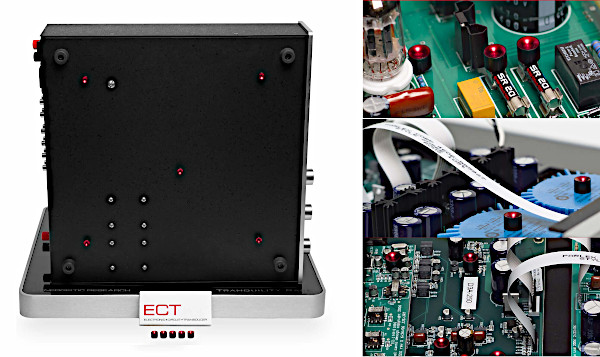
Interlude 4: How do the HFTs work?
I am sure there is an explanation, it is all physics anyway. For myself I designed several theories and I trust that some of them are correct – maybe all of them are correct. I must acknowledge that Ted Denney knows exactly what he is doing, no matter that the whole thing is probably much more complex than even Synergistic Research suggests.
Why don’t just accept that it works? There are always naysayers who say it can't, till the day they take a plunge and find out that they can’t fall off the flat Earth. Except loudspeakers I don’t know of any other audio component that lets you move the elements of sound like the HFTs do. They have far more impact than change in amplification, sources or cabling, of course provided that there are not fatal errors in other parts of the system.
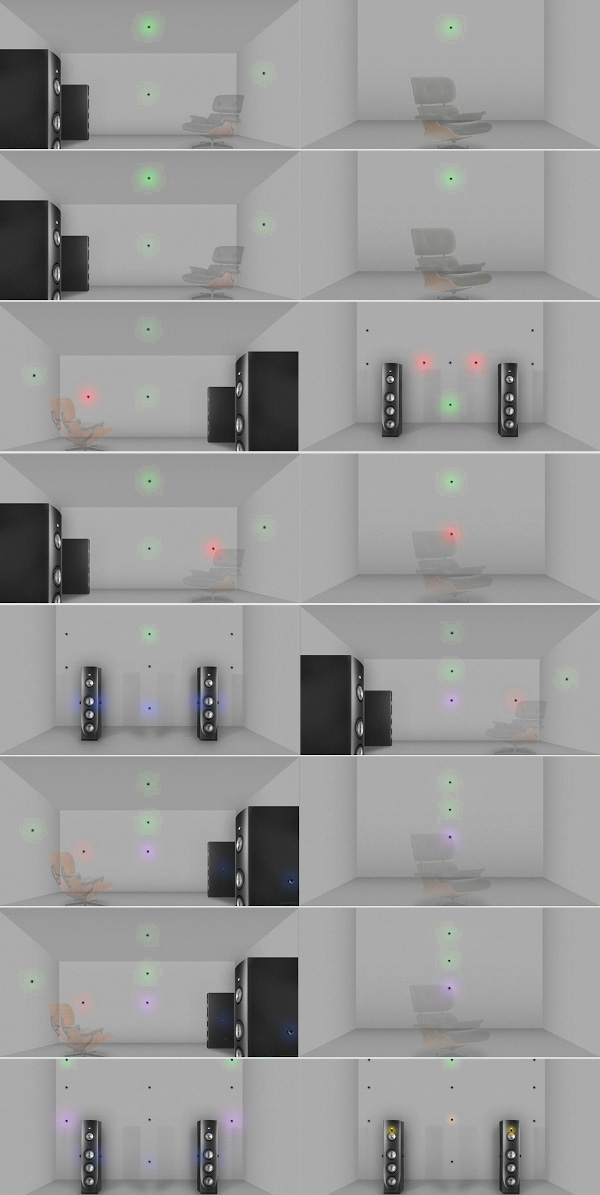
Resumé
Contrary to my original expectations (and my Zen ignorance) the review of Synergistic Research’s HFT bundle has become my biggest adventure in hi-fi so far. Not only the HFTs did change what I was hearing from the speakers but they did so in an often dramatic way. Especially the HFT-Xs and HFT 2.0s were little gems that in carefully tuned combinations worked like a charm.
I strongly recommend to buy only at an official dealer for one reason: he can equip you with different types of the HFTs and have the experience to make at least the initial installation for you. If you want to take a risk and buy second-hand or on internet, then do not buy more than 2 HFT standard packs. These 2 are quite easy to place with some experimentation. Once you enter the specialized types or more standard packs then without knowing how they would interact with your room and equipment you may lose your money on something that you don’t need; it’s too easy to have too much or too few of them and they are not cheap.
Other than that the HFT concept is the most intriguing I know of and deserves my highest recommendation.
A note on the HFT versus the ASI Sugar Cubes
In my review of the ASI Sugar Cubes I wrote: The purpose and the way of use of the HFTs and the Sugar Cubes are similar, though their principles are quite different, but the jaw-dropping effect is just as powerful. […] I was pleased to find that the two systems are highly complementary and mutually reinforcing. It is better to create a basic skeleton with HFTs as they are more efficient, but for finer tuning the Sugar Cubes are irreplaceable.
My opinion remains unchanged. With the HFT you will re-sculpt the sound to your liking, however, a one moment you reach the point when an addtion of any HFT makes no improvement whatsover. Then it is time to employ the Sugar Cubes and keep sculpting. I also noted that with a change in my audio gear I do not need to reposition the HFTs. But I need to turn the ASI Sugar Cubes around or flip them upside down to re-adjust the sound. No matter what, I would not be able to exist without both systems in my room.
Contact: Platan Audio, Hlohovec / Bratislava, tel. +421 905 409 802
Manufecturer's website: http://www.synergisticresearch.com



